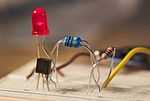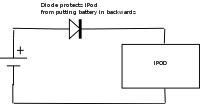Direct current/Diodes
< Direct current| Direct current |
|---|
 |
| General electronics |
|
|
|
Diodes are the basic building blocks for most semiconductor devices. They are part of the bipolar family of devices.
Diodes consist of two semiconductor materials, one doped with a deficiency of electrons called p-type material, and the other side is doped with an extra abundancy of electrons called n-type material. A process known as doping the material is what makes some parts of the diode p-type and the other parts n-type. While growing the semiconductor crystal, a small amount of arsenic or phosporous can be mixed in with the process and dope the material. To change the type of material from p to n type, one can add some n-type chemicals to swamp out the p-type materials already in the 'substrate'.
When you get done with the making of a diode, you have two types of material in direct contact with one another - this is called an abrupt pn-junction. The p-side is called the anode and collects the electrons emitted from the cathode, the n-side.
Consider the following circuit drawing. 
Benjamin Franklin was an early experimenter with electrical devices and setup the convention for current flow. All electrical engineers around the world use his convention for current flow and it states that current flows from the positive terminal of the battery through the circuit returning back to the negative terminal. The fact is that electrons flow the opposite way. Concern is not over the direction of the electron's flow(which only makes up half of the particles participating in electricity), but the direction of the charge.
Current flows in the diode from the P terminal to the N terminal, NOT the other way around (even though electrons flow the opposite way).
In this circuit, the diode is reverse biased, i.e. OFF and it does not conduct ... unless the voltage across the battery is so high that the diode breaks down in the reverse mode. Zener diodes are built to break down at a controlled voltage in the reverse mode; diodes are built to stand-off voltage, the simplest usually is good for 50V, the 1N4001 diode is an example. The 1N4002 is good for 100V; 1N4003 200V; 1N4004 400V; 1N4005 600V; 1N4006 600V; 1N4007 1000V.
When the diode or the battery is hooked up in the opposite connection (with the anode side connected to the plus terminal of the battery and the cathode side connected to the negative side of the battery), current will flow through both the diode and the resistor equally and return back to the battery.
The voltage drop across the diode is generally quoted at 0.5 to 0.75V, but that number depends upon the current though the diode and the temperature of the diode. For our purposes of discussion at this point, 0.6V is good starting point and the value of current is now a function of the battery voltage, Vbatt, and the resistor value, R.
math I = (Vbatt - 0.6)/R
The resistor is used to limit the current in the diode. The 1N4001 for example should be limited to carry no more than 1 Ampere of current. At this high current value, the 1N4001 will exhibit about 1.1 V drop (not 0.6V).
Diodes are extremely useful devices since they allow current to flow in one direction but not the other.

In this example, an expensive electronic device is protected from inadvertantly plugging its batteries in backwards. The current
can only flow through the diode when the battery is hooked up with the proper polarity.
In practice, this diode would have an unacceptably high voltage drop for a portable application, but MOSFETs with high-current low-rdson can be used to perform this function since the MOSFET also inherently has a diode built into its back-gate which can be used to start up the circuit ... once running, the circuit can enhance the gate of the MOSFET and reduce its forward drop to a small fraction of the voltage that would run across a diode.
Enough for now ... there is much to learn about diodes ...
External Links
- Rectification Basics: Electronics for Beginners